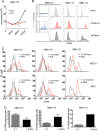Human Cytomegalovirus-Infected Glioblastoma Cells Display Stem Cell-Like Phenotypes
- PMID: 28656174
- PMCID: PMC5480031
- DOI: 10.1128/mSphere.00137-17
Human Cytomegalovirus-Infected Glioblastoma Cells Display Stem Cell-Like Phenotypes
Abstract
Glioblastoma multiforme (GBM) is the most common brain tumor in adults. Human cytomegalovirus (HCMV) genomes are present in GBM tumors, yielding hope that antiviral treatments could prove therapeutic and improve the poor prognosis of GBM patients. We discovered that GBM cells infected in vitro with HCMV display properties of cancer stem cells. HCMV-infected GBM cells grow more slowly than mock-infected controls, demonstrate a higher capacity for self-renewal determined by a sphere formation assay, and display resistance to the chemotherapeutic drug temozolomide. Our data suggest that HCMV, while present in only a minority of the cells within a tumor, could contribute to the pathogenesis of GBMs by promoting or prolonging stem cell-like phenotypes, thereby perpetuating tumors in the face of chemotherapy. Importantly, we show that temozolomide sensitivity is restored by the antiviral drug ganciclovir, indicating a potential mechanism underlying the positive effects observed in GBM patients treated with antiviral therapy. IMPORTANCE A role for HCMV in GBMs remains controversial for several reasons. Some studies find HCMV in GBM tumors, while others do not. Few cells within a GBM may harbor HCMV, making it unclear how the virus could be contributing to the tumor phenotype without infecting every cell. Finally, HCMV does not overtly transform cells in vitro. However, tumors induced by other viruses can be treated with antiviral remedies, and initial results indicate that this may be true for anti-HCMV therapies and GBMs. With such a poor prognosis for GBM patients, any potential new intervention deserves exploration. Our work here describes an evidence-based model for how HCMV could contribute to GBM biology while infecting very few cells and without transforming them. It also illuminates why anti-HCMV treatments may be beneficial to GBM patients. Our observations provide blueprints for future in vitro studies examining how HCMV manipulates stem cell-specific pathways and future clinical studies of anti-HCMV measures as GBM therapeutics.
Keywords: brain cancer; cancer; chemoresistance; chemotherapy; herpesvirus.
Figures







Similar articles
-
Cytomegalovirus infection induces a stem cell phenotype in human primary glioblastoma cells: prognostic significance and biological impact.Cell Death Differ. 2016 Feb;23(2):261-9. doi: 10.1038/cdd.2015.91. Epub 2015 Jul 3. Cell Death Differ. 2016. PMID: 26138445 Free PMC article.
-
Impact of human cytomegalovirus on glioblastoma cell viability and chemotherapy treatment.J Gen Virol. 2018 Sep;99(9):1274-1285. doi: 10.1099/jgv.0.001118. Epub 2018 Jul 27. J Gen Virol. 2018. PMID: 30045780
-
Significant association of multiple human cytomegalovirus genomic Loci with glioblastoma multiforme samples.J Virol. 2012 Jan;86(2):854-64. doi: 10.1128/JVI.06097-11. Epub 2011 Nov 16. J Virol. 2012. PMID: 22090104 Free PMC article.
-
Cytomegalovirus and brain tumor: epidemiology, biology and therapeutic aspects.Curr Opin Oncol. 2013 Nov;25(6):682-8. doi: 10.1097/CCO.0000000000000005. Curr Opin Oncol. 2013. PMID: 24097102 Review.
-
Human cytomegalovirus-mediated immunomodulation: Effects on glioblastoma progression.Biochim Biophys Acta Rev Cancer. 2017 Aug;1868(1):273-276. doi: 10.1016/j.bbcan.2017.05.006. Epub 2017 May 26. Biochim Biophys Acta Rev Cancer. 2017. PMID: 28554666 Review.
Cited by
-
SOX2 downregulation of PML increases HCMV gene expression and growth of glioma cells.PLoS Pathog. 2023 Apr 14;19(4):e1011316. doi: 10.1371/journal.ppat.1011316. eCollection 2023 Apr. PLoS Pathog. 2023. PMID: 37058447 Free PMC article.
-
The Pentamer glycoprotein complex inhibits viral Immediate Early transcription during Human Cytomegalovirus infections.Proc Natl Acad Sci U S A. 2024 Sep 24;121(39):e2408078121. doi: 10.1073/pnas.2408078121. Epub 2024 Sep 18. Proc Natl Acad Sci U S A. 2024. PMID: 39292744 Free PMC article.
-
Human Cytomegalovirus Productively Replicates In Vitro in Undifferentiated Oral Epithelial Cells.J Virol. 2018 Jul 31;92(16):e00903-18. doi: 10.1128/JVI.00903-18. Print 2018 Aug 15. J Virol. 2018. PMID: 29848590 Free PMC article.
-
ATRX restricts Human Cytomegalovirus (HCMV) viral DNA replication through heterochromatinization and minimizes unpackaged viral genomes.PLoS Pathog. 2024 Sep 5;20(9):e1012516. doi: 10.1371/journal.ppat.1012516. eCollection 2024 Sep. PLoS Pathog. 2024. PMID: 39236084 Free PMC article.
-
Expanding the Known Functional Repertoire of the Human Cytomegalovirus pp71 Protein.Front Cell Infect Microbiol. 2020 Mar 12;10:95. doi: 10.3389/fcimb.2020.00095. eCollection 2020. Front Cell Infect Microbiol. 2020. PMID: 32226778 Free PMC article. Review.
References
-
- Hariri S, Bennett NM, Niccolai LM, Schafer S, Park IU, Bloch KC, Unger ER, Whitney E, Julian P, Scahill MW, Abdullah N, Levine D, Johnson ML, Steinau M, Markowitz LE, HPV-IMPACT Working Group . 2015. Reduction in HPV 16/18-associated high grade cervical lesions following HPV vaccine introduction in the United States − 2008 2012. Vaccine 33:1608–1613. doi:10.1016/j.vaccine.2015.01.084. - DOI - PMC - PubMed
Grants and funding
LinkOut - more resources
Full Text Sources
Other Literature Sources

